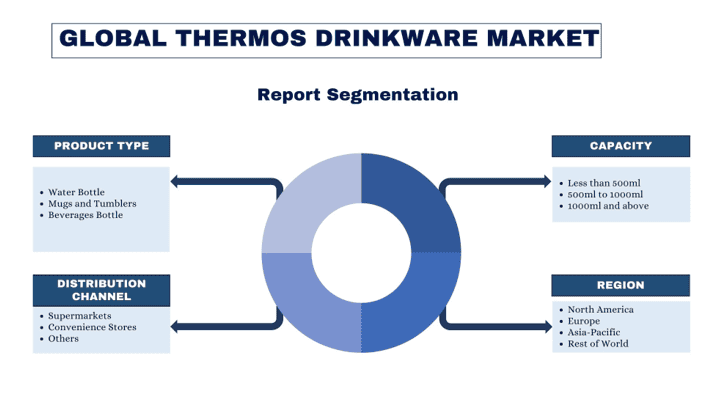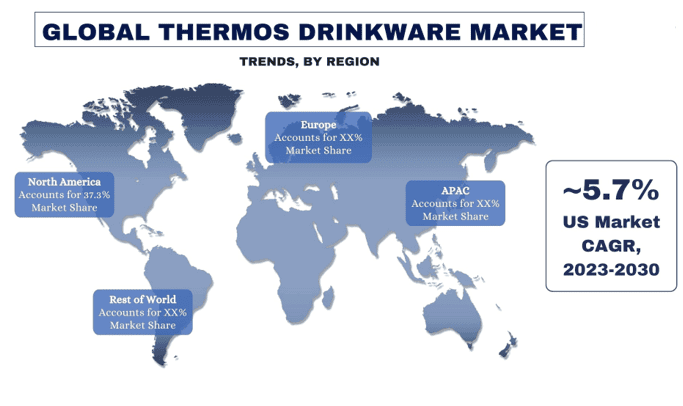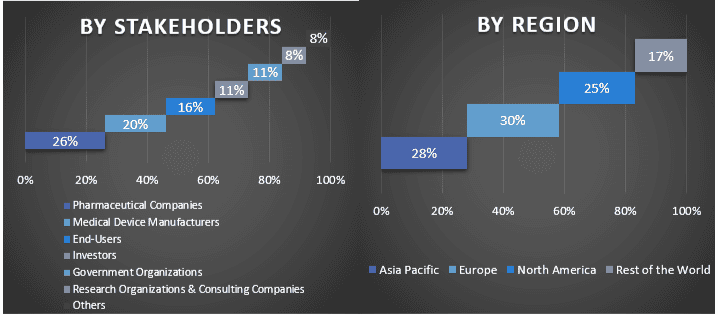- Trang chủ
- Về chúng tôi
- Ngành
- Dịch vụ
- Đọc
- Liên hệ với chúng tôi
Thị trường Đồ đựng Thức uống Thermos: Phân tích Hiện tại và Dự báo (2023-2030)
Nhấn mạnh vào Loại Sản phẩm (Bình nước, Cốc và Ly giữ nhiệt, và Chai đựng đồ uống); Dung tích (Dưới 500ml, 500ml đến 1000ml, và 1000ml trở lên); Kênh phân phối (Siêu thị, Cửa hàng tiện lợi, và Khác); Khu vực/Quốc gia.

Quy mô & Dự báo của Thị trường Đồ uống Giữ Nhiệt
Giá trị thị trường đồ uống giữ nhiệt đạt 3277,28 triệu USD vào năm 2022 và dự kiến sẽ tăng trưởng với tốc độ CAGR mạnh mẽ khoảng 6% trong giai đoạn dự báo (2023-2030) nhờ các hoạt động thể thao ngày càng tăng.
Phân tích Thị trường Đồ uống Giữ Nhiệt
Thị trường đồ uống giữ nhiệt đang trải qua sự gia tăng về mức độ phổ biến, được thúc đẩy bởi sự kết hợp của các yếu tố phục vụ cho cả ý thức về môi trường và sở thích của người tiêu dùng đang phát triển
Theo một báo cáo năm 2023 của Cơ quan Thống kê Canada, gần 60% người Canada cho biết họ sử dụng bình nước tái sử dụng, làm nổi bật sự ưa chuộng ngày càng tăng đối với các giải pháp hydrat hóa bền vững và tiện lợi.
Theo một báo cáo năm 2023 của Bộ Chuyển đổi Sinh thái Pháp (ADEME), đã có sự gia tăng 20% trong việc mua đồ uống tái sử dụng của các hộ gia đình Pháp, với đồ thủy tinh giữ nhiệt dẫn đầu
Vào tháng 4 năm 2023, Reduce, đã công bố ra mắt trên toàn quốc tại Walmart với năm màu mới, hai thiết kế độc quyền tập trung vào mùa hè và một sản phẩm hoàn toàn mới ngay trước thời tiết ấm áp hơn. Việc triển khai, sau một thử nghiệm thành công tại 150 cửa hàng đối với dòng sản phẩm đồ uống của công ty kể từ tháng 4 năm 2022, sẽ nổi bật tại tất cả hơn 3.000 cửa hàng Walmart với các đầu kệ sản phẩm cho đến tháng 7 năm 2023. Xu hướng Thị trường Đồ uống Giữ Nhiệt
Phần này thảo luận về các xu hướng thị trường chính đang ảnh hưởng đến các phân khúc khác nhau của Thị trường Đồ uống Giữ Nhiệt theo xác định của nhóm chuyên gia nghiên cứu của chúng tôi.
Các Thiết bị Chai Đựng Đồ uống Đang Chuyển đổi Ngành
Phân khúc chai đựng đồ uống trong thị trường đồ uống giữ nhiệt đã chứng kiến sự tăng trưởng ổn định trong những năm qua, được thúc đẩy bởi nhu cầu ngày càng tăng đối với các hộp đựng cách nhiệt, di động cho đồ uống. Sự tăng trưởng này có thể là do các yếu tố như sự nhấn mạnh ngày càng tăng vào tính bền vững, lối sống có ý thức về sức khỏe và sự tiện lợi của việc mang đồ uống trong các hộp đựng cách nhiệt. Ngoài ra, những tiến bộ trong công nghệ đã dẫn đến sự phát triển của các tính năng cải tiến trong chai đựng đồ uống, chẳng hạn như khả năng cách nhiệt chân không và giữ nhiệt độ, thúc đẩy hơn nữa sự mở rộng thị trường. Bên cạnh đó, sự gia tăng dân số làm việc và sự gia tăng liên kết trong việc tiêu thụ đồ uống trà hoặc cà phê cũng đang tác động đến sự tăng trưởng của phân khúc trong những năm tới. Theo, World Tea News, 297 tỷ lít trà đã được tiêu thụ trên toàn thế giới vào năm 2021.

Châu Á Thái Bình Dương Dự kiến sẽ Tăng trưởng với CAGR Đáng kể Trong Giai đoạn Dự báo
Khu vực Châu Á Thái Bình Dương được dự đoán sẽ tăng trưởng với CAGR cao trong giai đoạn sắp tới. Thị trường đồ uống giữ nhiệt Châu Á Thái Bình Dương đang trải qua sự bùng nổ, được thúc đẩy bởi một số yếu tố chính. Thu nhập khả dụng ngày càng tăng, cùng với ý thức ngày càng tăng về sức khỏe và tính bền vững, đang thúc đẩy nhu cầu đối với các hộp đựng đồ uống tiện lợi và đa chức năng này. Hơn nữa, có một sự thay đổi ngày càng tăng đối với các hoạt động bền vững. Người tiêu dùng đang lựa chọn các sản phẩm có thể tái sử dụng và đồ uống giữ nhiệt cung cấp một giải pháp thay thế lâu dài và thân thiện với môi trường cho các loại cốc dùng một lần. Điều này hoàn toàn phù hợp với các sáng kiến của chính phủ nhằm thúc đẩy tính bền vững. Ví dụ, chiến dịch “Swachh Bharat Abhiyan” (Chiến dịch Ấn Độ Sạch) của Ấn Độ khuyến khích việc sử dụng các sản phẩm có thể tái sử dụng, tạo ra một môi trường thuận lợi cho thị trường đồ uống giữ nhiệt. Ngoài ra, xu hướng sống ở đô thị ngày càng tăng ở các quốc gia như Ấn Độ cũng đang kích thích nhu cầu về đồ uống di động, để cung cấp các giải pháp tiện lợi để giữ nước tại nơi làm việc.
Theo một báo cáo năm 2023 của Trung tâm Nghiên cứu Quản lý và Thành phần Chất thải Hộ gia đình Quốc gia Trung Quốc, chất thải nhựa dùng một lần ở Trung Quốc đã đạt mức đáng báo động là 60 triệu tấn mỗi năm. Đồ thủy tinh giữ nhiệt mang đến một giải pháp thay thế bền vững và có thể tái sử dụng, hoàn toàn phù hợp với mong muốn giảm chất thải. Hơn nữa, với tầng lớp trung lưu ngày càng ưu tiên sức khỏe, nhu cầu về các sản phẩm duy trì nhiệt độ đồ uống trong thời gian dài đang tăng lên. Xu hướng này đặc biệt rõ ràng ở giới trẻ, vì một cuộc khảo sát năm 2023 của Bộ Giáo dục tiết lộ rằng hơn 70% sinh viên đại học ở Trung Quốc tích cực mang theo bình nước tái sử dụng.

Tổng quan về Ngành Đồ uống Giữ Nhiệt
Thị trường đồ uống giữ nhiệt mang tính cạnh tranh và phân mảnh, với sự hiện diện của một số công ty kinh doanh trên thị trường toàn cầu và quốc tế. Các công ty kinh doanh chủ chốt đang áp dụng các chiến lược tăng trưởng khác nhau để nâng cao sự hiện diện trên thị trường của họ, chẳng hạn như hợp tác, thỏa thuận, cộng tác, ra mắt sản phẩm mới, mở rộng địa lý và sáp nhập và mua lại. Một số công ty kinh doanh lớn trên thị trường là Sigg Switzerland AG; Thermos L.L.C.; TIGER CORPORATION; Camelbak; Zojirushi America Corporation.; Stanley PMI; Klean Kanteen; Hydro Flask; KINTO Co., Ltd.; và Contigo Brands.
Tin tức Thị trường Đồ uống Giữ Nhiệt
- Vào tháng 8 năm 2020, Xiaomi Corporation đã ra mắt Bình giữ nhiệt Mija Bullet, một chai nước chứa lớp chân không dựa trên công nghệ hàn laser bên trong. Sản phẩm như vậy có khả năng giữ lạnh/nóng trong 12 giờ với dung tích 500ml.
- Vào tháng 2 năm 2024, Thermos Canada đã công bố hợp tác với Hiệp hội Công viên và Vùng hoang dã Canada (CPAWS) để thúc đẩy thói quen hydrat hóa có trách nhiệm trong các công viên quốc gia. Sáng kiến này làm nổi bật sự hợp lực ngày càng tăng giữa đồ thủy tinh giữ nhiệt và người tiêu dùng năng động, có ý thức về sinh thái ở Canada.
- Vào tháng 2 năm 2024, Thermos Mexico đã công bố ra mắt chiến dịch “Hidrate y Logra”, thúc đẩy tầm quan trọng của việc duy trì hydrat hóa với dòng chai nước cách nhiệt của mình. Sự tập trung vào sức khỏe và tính bền vững này định vị đồ thủy tinh giữ nhiệt như một công cụ quan trọng cho một bộ phận người tiêu dùng Mexico đang phát triển.
Phạm vi Báo cáo Thị trường Đồ uống Giữ Nhiệt
Thuộc tính Báo cáo | Chi tiết |
Năm cơ sở | 2022 |
Giai đoạn dự báo | 2023-2030 |
Động lực tăng trưởng | Tăng tốc với CAGR 6% |
Quy mô thị trường 2022 | 3277 triệu USD |
Phân tích khu vực | Bắc Mỹ, Châu Âu, APAC, Phần còn lại của Thế giới |
Khu vực đóng góp chính | Châu Á-Thái Bình Dương dự kiến sẽ tăng trưởng với CAGR cao nhất trong giai đoạn dự báo |
Các quốc gia chính được đề cập | Hoa Kỳ, Canada, Đức, Vương quốc Anh, Tây Ban Nha, Ý, Pháp, Trung Quốc, Nhật Bản và Ấn Độ |
Các công ty được mô tả | Sigg Switzerland AG; Thermos L.L.C.; TIGER CORPORATION; Camelbak; Zojirushi America Corporation.; Stanley PMI; Klean Kanteen; Hydro Flask; KINTO Co., Ltd.; và Contigo Brands. |
Phạm vi Báo cáo | Xu hướng, Động lực và Hạn chế Thị trường; Ước tính và Dự báo Doanh thu; Phân tích Phân khúc; Tác động của COVID-19; Phân tích Cung và Cầu; Bối cảnh Cạnh tranh; Mô tả Công ty |
Các Phân khúc Được Đề cập | Theo Loại Sản phẩm; Theo Dung tích; Theo Kênh Phân phối; Theo Khu vực/Quốc gia |
Lý do nên mua báo cáo này:
- Nghiên cứu bao gồm phân tích định cỡ và dự báo thị trường được xác thực bởi các chuyên gia ngành chủ chốt đã được xác thực.
- Báo cáo trình bày đánh giá nhanh về hiệu suất tổng thể của ngành trong nháy mắt.
- Báo cáo bao gồm phân tích chuyên sâu về các đối thủ cạnh tranh nổi bật trong ngành với trọng tâm chính vào tình hình tài chính kinh doanh chủ chốt, danh mục sản phẩm, chiến lược mở rộng và các phát triển gần đây.
- Kiểm tra chi tiết các động lực, hạn chế, xu hướng chính và cơ hội hiện hành trong ngành.
- Nghiên cứu bao quát toàn diện thị trường trên các phân khúc khác nhau.
- Phân tích sâu về ngành ở cấp độ khu vực.
Tùy chọn Tùy chỉnh:
Thị trường đồ uống giữ nhiệt toàn cầu có thể được tùy chỉnh thêm theo yêu cầu hoặc bất kỳ phân khúc thị trường nào khác. Bên cạnh đó, UMI hiểu rằng bạn có thể có nhu cầu kinh doanh riêng, vì vậy hãy thoải mái liên hệ với chúng tôi để nhận được một báo cáo hoàn toàn phù hợp với yêu cầu của bạn.
Mục lục
Phương Pháp Nghiên Cứu Phân Tích Thị Trường Đồ Uống Giữ Nhiệt (2023-2030)
Phân tích thị trường lịch sử, ước tính thị trường hiện tại và dự báo thị trường tương lai của thị trường đồ uống giữ nhiệt toàn cầu là ba bước chính được thực hiện để tạo và phân tích việc áp dụng đồ uống giữ nhiệt ở các khu vực lớn trên toàn cầu. Nghiên cứu thứ cấp toàn diện đã được thực hiện để thu thập số liệu thị trường lịch sử và ước tính quy mô thị trường hiện tại. Thứ hai, để xác thực những thông tin chi tiết này, nhiều phát hiện và giả định đã được xem xét. Hơn nữa, các cuộc phỏng vấn sơ cấp toàn diện cũng được thực hiện với các chuyên gia trong ngành trên toàn bộ chuỗi giá trị của thị trường đồ uống giữ nhiệt toàn cầu. Sau khi giả định và xác thực số liệu thị trường thông qua các cuộc phỏng vấn sơ cấp, chúng tôi đã sử dụng phương pháp tiếp cận từ trên xuống/từ dưới lên để dự báo quy mô thị trường hoàn chỉnh. Sau đó, các phương pháp phân tích chi tiết thị trường và phân tích tam giác dữ liệu đã được áp dụng để ước tính và phân tích quy mô thị trường của các phân khúc và phân đoạn phụ của ngành liên quan đến. Phương pháp chi tiết được giải thích dưới đây:
Phân Tích Quy Mô Thị Trường Lịch Sử
Bước 1: Nghiên Cứu Chuyên Sâu Các Nguồn Thứ Cấp:
Nghiên cứu thứ cấp chi tiết đã được thực hiện để thu thập quy mô thị trường lịch sử của thị trường đồ uống giữ nhiệt thông qua các nguồn nội bộ của công ty như báo cáo thường niên & báo cáo tài chính, thuyết trình hiệu quả hoạt động, thông cáo báo chí, v.v. và các nguồn bên ngoài bao gồm tạp chí, tin tức & bài báo, ấn phẩm của chính phủ, ấn phẩm của đối thủ cạnh tranh, báo cáo ngành, cơ sở dữ liệu của bên thứ ba và các ấn phẩm đáng tin cậy khác.
Bước 2: Phân Khúc Thị Trường:
Sau khi có được quy mô thị trường lịch sử của thị trường đồ uống giữ nhiệt, chúng tôi đã tiến hành phân tích thứ cấp chi tiết để thu thập thông tin chi tiết về thị trường lịch sử và chia sẻ cho các phân khúc & phân đoạn phụ khác nhau cho các khu vực lớn. Các phân khúc chính được bao gồm trong báo cáo như loại sản phẩm, dung tích và kênh phân phối. Các phân tích ở cấp quốc gia đã được tiến hành để đánh giá việc áp dụng chung các mô hình thử nghiệm ở khu vực đó.
Bước 3: Phân Tích Yếu Tố:
Sau khi thu thập được quy mô thị trường lịch sử của các phân khúc và phân đoạn phụ khác nhau, chúng tôi đã tiến hành phân tích yếu tố chi tiết để ước tính quy mô thị trường hiện tại của thị trường đồ uống giữ nhiệt. Hơn nữa, chúng tôi đã tiến hành phân tích yếu tố bằng cách sử dụng các biến phụ thuộc và độc lập như loại sản phẩm, dung tích và kênh phân phối của thị trường đồ uống giữ nhiệt. Một phân tích kỹ lưỡng đã được thực hiện cho các kịch bản cung và cầu, có tính đến các quan hệ đối tác hàng đầu, sáp nhập và mua lại, mở rộng kinh doanh và ra mắt sản phẩm trong lĩnh vực thị trường đồ uống giữ nhiệt trên toàn cầu.
Ước Tính & Dự Báo Quy Mô Thị Trường Hiện Tại
Xác định Quy Mô Thị Trường Hiện Tại: Dựa trên những thông tin chi tiết hữu ích từ 3 bước trên, chúng tôi đã đi đến quy mô thị trường hiện tại, những người chơi chính trong thị trường đồ uống giữ nhiệt toàn cầu và thị phần của các phân khúc. Tất cả các tỷ lệ phần trăm được yêu cầu chia tách và phân tích thị trường đã được xác định bằng cách sử dụng phương pháp thứ cấp đã đề cập ở trên và được xác minh thông qua các cuộc phỏng vấn sơ cấp.
Ước Tính & Dự Báo: Để ước tính và dự báo thị trường, trọng số đã được gán cho các yếu tố khác nhau bao gồm các yếu tố thúc đẩy & xu hướng, hạn chế và cơ hội có sẵn cho các bên liên quan. Sau khi phân tích các yếu tố này, các kỹ thuật dự báo có liên quan, tức là phương pháp tiếp cận từ trên xuống/từ dưới lên đã được áp dụng để đưa ra dự báo thị trường cho năm 2030 cho các phân khúc và phân đoạn phụ khác nhau trên các thị trường lớn trên toàn cầu. Phương pháp nghiên cứu được áp dụng để ước tính quy mô thị trường bao gồm:
- Quy mô thị trường của ngành, về doanh thu (USD) và tỷ lệ chấp nhận của thị trường đồ uống giữ nhiệt trên các thị trường lớn trong nước
- Tất cả các tỷ lệ phần trăm, phân chia và phân tích các phân khúc và phân đoạn phụ của thị trường
- Những người chơi chính trong thị trường đồ uống giữ nhiệt toàn cầu về các sản phẩm được cung cấp. Ngoài ra, các chiến lược tăng trưởng được những người chơi này áp dụng để cạnh tranh trong thị trường đang phát triển nhanh chóng
Xác Thực Quy Mô và Thị Phần Thị Trường
Nghiên Cứu Sơ Cấp: Các cuộc phỏng vấn chuyên sâu đã được thực hiện với những Người có Quan điểm Chủ chốt (KOL) bao gồm các Giám đốc Điều hành Cấp cao (CXO/VP, Trưởng phòng Kinh doanh, Trưởng phòng Marketing, Trưởng phòng Điều hành, Trưởng phòng Khu vực, Trưởng phòng Quốc gia, v.v.) trên khắp các khu vực lớn. Các phát hiện nghiên cứu sơ cấp sau đó được tóm tắt và phân tích thống kê đã được thực hiện để chứng minh giả thuyết đã nêu. Thông tin đầu vào từ nghiên cứu sơ cấp đã được hợp nhất với các phát hiện thứ cấp, do đó biến thông tin thành thông tin chi tiết hữu ích.
Phân Chia Người Tham Gia Sơ Cấp ở Các Khu Vực Khác Nhau

Kỹ Thuật Thị Trường
Kỹ thuật phân tích tam giác dữ liệu đã được sử dụng để hoàn thành việc ước tính thị trường tổng thể và để đưa ra các số liệu thống kê chính xác cho từng phân khúc và phân đoạn phụ của thị trường đồ uống giữ nhiệt toàn cầu. Dữ liệu đã được chia thành nhiều phân khúc & phân đoạn phụ sau khi nghiên cứu các thông số và xu hướng khác nhau trong các lĩnh vực loại sản phẩm, dung tích và kênh phân phối trong thị trường đồ uống giữ nhiệt toàn cầu.
Mục tiêu chính của Nghiên cứu Thị trường Đồ uống Giữ nhiệt Toàn cầu
Các xu hướng thị trường hiện tại & tương lai của thị trường đồ uống giữ nhiệt toàn cầu đã được xác định trong nghiên cứu. Các nhà đầu tư có thể thu được những thông tin chi tiết chiến lược để làm cơ sở cho quyết định đầu tư của họ dựa trên phân tích định tính và định lượng được thực hiện trong nghiên cứu. Các xu hướng thị trường hiện tại và tương lai xác định mức độ hấp dẫn tổng thể của thị trường ở cấp khu vực, cung cấp một nền tảng cho người tham gia công nghiệp khai thác thị trường chưa được khai thác để hưởng lợi từ lợi thế của người đi đầu. Các mục tiêu định lượng khác của các nghiên cứu bao gồm:
- Phân tích quy mô thị trường hiện tại và dự báo của thị trường đồ uống giữ nhiệt về giá trị (USD). Ngoài ra, phân tích quy mô thị trường hiện tại và dự báo của các phân khúc và phân đoạn phụ khác nhau
- Các phân khúc trong nghiên cứu bao gồm các lĩnh vực loại sản phẩm, dung tích và kênh phân phối
- Xác định và phân tích khung pháp lý cho ngành công nghiệp đồ uống giữ nhiệt
- Phân tích chuỗi giá trị liên quan đến sự hiện diện của các trung gian khác nhau, cùng với việc phân tích hành vi của khách hàng và đối thủ cạnh tranh trong ngành
- Phân tích quy mô thị trường hiện tại và dự báo của thị trường đồ uống giữ nhiệt cho khu vực chính
- Các quốc gia lớn của các khu vực được nghiên cứu trong báo cáo bao gồm Châu Á Thái Bình Dương, Châu Âu, Bắc Mỹ và Phần còn lại của Thế giới
- Hồ sơ công ty của thị trường đồ uống giữ nhiệt và các chiến lược tăng trưởng được những người chơi trên thị trường áp dụng để duy trì trong thị trường đang phát triển nhanh chóng
- Phân tích chuyên sâu ở cấp khu vực của ngành
Câu hỏi thường gặp Câu hỏi thường gặp
Câu hỏi 1: Quy mô thị trường hiện tại và tiềm năng tăng trưởng của thị trường bình giữ nhiệt là gì?
Q2: Đâu là những yếu tố thúc đẩy sự tăng trưởng của thị trường bình giữ nhiệt?
Q3: Phân khúc nào chiếm thị phần lớn nhất trong thị trường bình giữ nhiệt theo loại sản phẩm?
Câu hỏi 4: Các công nghệ và xu hướng mới nổi trong thị trường bình giữ nhiệt là gì?
Câu hỏi 5: Khu vực nào sẽ chiếm lĩnh thị trường bình giữ nhiệt?
Liên quan Báo cáo
Khách hàng đã mua mặt hàng này cũng đã mua










